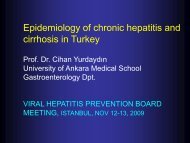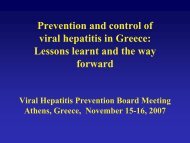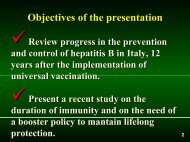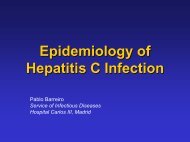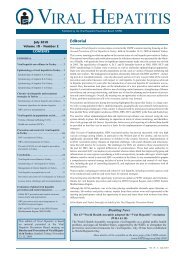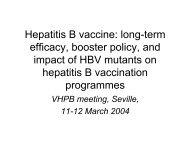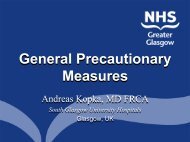Prevention and control of perinatal hepatitis B virus transmission in ...
Prevention and control of perinatal hepatitis B virus transmission in ...
Prevention and control of perinatal hepatitis B virus transmission in ...
You also want an ePaper? Increase the reach of your titles
YUMPU automatically turns print PDFs into web optimized ePapers that Google loves.
diagnosis. In the past, the <strong>in</strong>cidence <strong>of</strong> <strong>hepatitis</strong> B <strong>in</strong> Pol<strong>and</strong> was approx. 45 reported cases per100,000 population, but follow<strong>in</strong>g the <strong>in</strong>troduction <strong>of</strong> improved sterilization <strong>of</strong> medical equipment<strong>in</strong> 1986 <strong>and</strong> a selective programme <strong>of</strong> vacc<strong>in</strong>ation <strong>in</strong> 1991, the <strong>in</strong>cidence fell to about 35 per100,000 by 1993. In 1993, an <strong>in</strong>tensive vacc<strong>in</strong>ation campaign was launched, which has reducedthe <strong>in</strong>cidence to under 15 per 100,000. The <strong>in</strong>cidence <strong>of</strong> HBV <strong>in</strong>fection has decreased across allage groups <strong>and</strong> <strong>in</strong> both men <strong>and</strong> women, <strong>and</strong> <strong>in</strong> the under 3 years age group only 32 cases <strong>in</strong> totalwere reported <strong>in</strong> 1997. In 1996 <strong>and</strong> 1997, there was a slight relative <strong>in</strong>crease <strong>in</strong> the <strong>in</strong>cidence <strong>of</strong>HBV <strong>in</strong>fection <strong>in</strong> men aged 20-24 years. This group may be a target for future vacc<strong>in</strong>ationprogrammes <strong>and</strong> other activities <strong>of</strong> <strong>control</strong> for the <strong>in</strong>fection.Mast EE, Alter MJ, Margolis HS. Strategies to prevent <strong>and</strong> <strong>control</strong> <strong>hepatitis</strong> B <strong>and</strong> C <strong>virus</strong><strong>in</strong>fections: a global perspective. Vacc<strong>in</strong>e 1999; 17:1730-1733.Hepatitis Branch, Division <strong>of</strong> Viral <strong>and</strong> Rickettsial Diseases, National Center for InfectiousDiseases, Centers for Disease Control <strong>and</strong> <strong>Prevention</strong>, Atlanta, GA 30306, USA. eem1@cdc.govHepatitis B <strong>virus</strong> (HBV) <strong>and</strong> <strong>hepatitis</strong> C <strong>virus</strong> (HCV) are major causes <strong>of</strong> acute <strong>and</strong> chronic liverdisease worldwide. Chronic <strong>in</strong>fection with these <strong>virus</strong>es <strong>of</strong>ten leads to chronic liver disease,<strong>in</strong>clud<strong>in</strong>g cirrhosis or primary hepatocellular carc<strong>in</strong>oma. Both HBV <strong>and</strong> HCV are bloodborne<strong>virus</strong>es; however, HBV is transmitted efficiently by both percutaneous <strong>and</strong> mucosal exposures,<strong>and</strong> HCV is transmitted predom<strong>in</strong>antly by percutaneous exposures. Because the relativeimportance <strong>of</strong> various modes <strong>of</strong> <strong>transmission</strong> <strong>of</strong> these <strong>virus</strong>es differs by country, the choice <strong>of</strong>specific prevention <strong>and</strong> <strong>control</strong> strategies depends primarily on the epidemiology <strong>of</strong> <strong>in</strong>fection <strong>in</strong> aparticular country. Comprehensive <strong>hepatitis</strong> B prevention strategies should <strong>in</strong>clude (1) prevention<strong>of</strong> <strong>per<strong>in</strong>atal</strong> HBV <strong>transmission</strong>, (2) <strong>hepatitis</strong> B vacc<strong>in</strong>ation at critical ages to <strong>in</strong>terrupt <strong>transmission</strong><strong>and</strong> (3) prevention <strong>of</strong> nosocomial HBV <strong>transmission</strong>. The prevention <strong>of</strong> <strong>hepatitis</strong> C is problematicbecause a vacc<strong>in</strong>e to prevent HCV <strong>in</strong>fection is not expected to be developed <strong>in</strong> the foreseeablefuture. From a global perspective, the greatest impact on the disease burden associated with HCV<strong>in</strong>fection will most likely be achieved by focus<strong>in</strong>g efforts on primary prevention strategies toreduce or elim<strong>in</strong>ate the risk for <strong>transmission</strong> from nosocomial exposures (e.g., blood transfusion,unsafe <strong>in</strong>jection practices) <strong>and</strong> high-risk practices (e.g., <strong>in</strong>ject<strong>in</strong>g drug use).Mast EE, Hwang LY, Seto DS, Nolte FS, Na<strong>in</strong>an OV, Wurtzel H, Alter MJ. Risk factors for<strong>per<strong>in</strong>atal</strong> <strong>transmission</strong> <strong>of</strong> <strong>hepatitis</strong> C <strong>virus</strong> (HCV) <strong>and</strong> the natural history <strong>of</strong> HCV <strong>in</strong>fectionacquired <strong>in</strong> <strong>in</strong>fancy. J Infect Dis 2005; 192:1880-1889.Centers for Disease Control <strong>and</strong> <strong>Prevention</strong>, Atlanta, GA 30333, USA. emast@cdc.govThe goal <strong>of</strong> the present study was to assess risk factors for <strong>per<strong>in</strong>atal</strong> <strong>hepatitis</strong> C <strong>virus</strong> (HCV)<strong>transmission</strong> <strong>and</strong> the natural history <strong>of</strong> <strong>in</strong>fection among HCV-<strong>in</strong>fected <strong>in</strong>fants. In a cohort study,244 <strong>in</strong>fants born to HCV-positive mothers were followed from birth until age > or = 12 months.Maternal serum was collected at enrollment <strong>and</strong> delivery; <strong>in</strong>fant serum was collected at birth <strong>and</strong>at 8 well-child visits. Test<strong>in</strong>g <strong>in</strong>cluded detection <strong>of</strong> antibody to HCV, detection <strong>of</strong> HCV RNA(qualitative <strong>and</strong> quantitative), <strong>and</strong> genotyp<strong>in</strong>g. HCV-<strong>in</strong>fected <strong>in</strong>fants were followed annually untilage 5 years. Overall, 9 <strong>of</strong> 190 (4.7% [95% confidence <strong>in</strong>terval (CI), 2.3%-9.1%]) <strong>in</strong>fants born tomothers who were HCV RNA positive at delivery became <strong>in</strong>fected, compared with 0 <strong>of</strong> 54 <strong>in</strong>fantsborn to HCV RNA-negative mothers (P = 0.10). Among HCV RNA-positive mothers, the rate <strong>of</strong><strong>transmission</strong> was 3.8% (95% CI, 1.7%-8.1%) from the 182 who were human immunodeficiency<strong>virus</strong> (HIV) negative, compared with 25.0% (95% CI, 4.5%-64.4%) from the 8 who were HIVpositive (P < 0.05). Three <strong>in</strong>fected <strong>in</strong>fants resolved their <strong>in</strong>fection (i.e., became HCV RNAnegative). In multivariate analysis restricted to HCV RNA-positive mothers, membrane rupture >or = 6 h (odds ratio [OR], 9.3 [95% CI, 1.5-179.7]) <strong>and</strong> <strong>in</strong>ternal fetal monitor<strong>in</strong>g (OR, 6.7 [95%CI, 1.1-35.9]) were associated with <strong>transmission</strong> <strong>of</strong> HCV to <strong>in</strong>fants. If duration <strong>of</strong> membrane29





